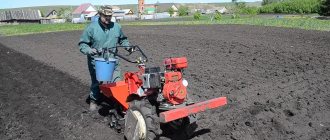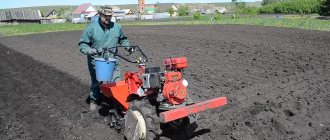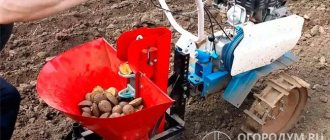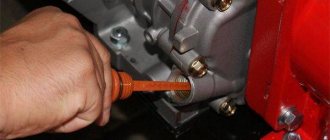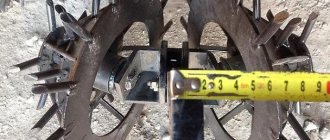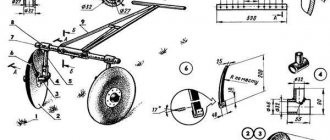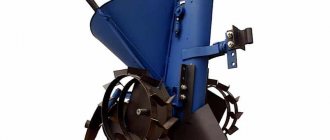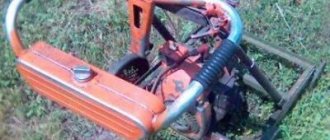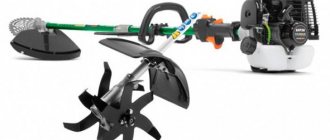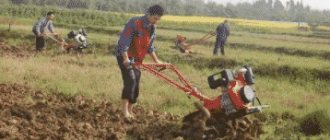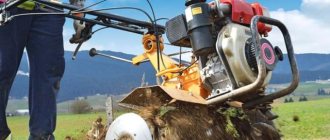Homemade blade for the MTZ-82 tractor.
MTZ tractors are widely used in public utilities and agriculture due to their relatively low cost, ease of operation, and good performance characteristics. Many owners of these units seek to modernize them and significantly expand their functionality. One of these improvements is a front or rear blade, which is indispensable when carrying out certain types of agricultural work, as well as when clearing snow drifts.
A homemade blade for the MTZ-82 tractor can become an indispensable assistant for any farmer when carrying out various types of work. There are a variety of types of this attachment on sale, but you can do it yourself, especially since there is nothing complicated about it. To make a blade, you will need drawings, appropriate materials and ability to handle the tool.
Do-it-yourself hedgehogs for weeding potatoes: drawings
The volume and quality of the harvest depends on proper and timely weeding of potatoes.
This common garden crop is responsive to weeding and requires weed control more than once or even twice during the season. Potatoes sprout after the appearance of weeds; in the future, one or more weedings have to be done in order to promptly remove weeds and improve the quality of garden produce. That is why weeding as an agrotechnical technique always takes a lot of effort and time from summer residents and gardeners. However, today many people use technical tools to make this work easier. In particular, hedgehogs are used on a potato cultivator. You can buy a motorized soil cultivator with ready-made trailers, but we will tell you how to make hedgehogs for weeding potatoes with your own hands, and we will also offer drawings below.
Hedgehogs for weeding: purpose and types
This is what hedgehogs look like for processing potatoes
Devices for removing weeds, in addition to their direct function, help solve several related problems at once:
- loosen the area of soil near the potato bush;
- reduce moisture loss;
- promote better tuber formation;
- Thanks to timely cultivation, potatoes of any variety are less affected by pests and diseases.
In large areas, it is difficult for summer residents and farmers to make do with primitive tools: hoes and rakes. Hand tools in the fields are being replaced by a cultivator walk-behind tractor and hedgehogs for mechanized weeding of potatoes.
There are two types of hedgehogs. This is a rotary hedgehog (used for weeding, making the soil fluffy, as a ripper and hiller for potato plantings). The cone hedgehog is good for working across the field both before emergence and during other periods.
Thanks to these functions, potatoes are hilled quickly, with a minimum of labor costs. This is the advantage of any type of hedgehog. It's easy to buy them today. But there is one significant drawback to ready-made devices - they are not cheap. You can reduce the cost of purchasing equipment by building a hedgehog with your own hands.
Homemade devices are affordable, simple and reliable. They can be made from scrap materials and those that are sold in any hardware department of a hardware store.
Hand tools
In small areas it is more convenient to use homemade tools. This could be a hoe, a hoe or a flat cutter. The most common are hoes and choppers. It makes no sense to buy expensive equipment to cultivate 2 acres of land. Simple tools differ in shape, which affects the process of removing weeds.
Read also: Reasons for iron not heating
Weeding several beds is best done with a hoe. It is lightweight and therefore easy to use. During the summer season, you can also use a hoe. There are several types. Most gardeners prefer two-horned models.
If a person wants to spend less physical effort in the garden, you can use a manual flat cutter. It has a simple design, but effectively removes wild plants. Weeding a garden with this device is very easy. A person has the opportunity to change the angle of inclination at his own discretion.
Hedgehog designs and drawings
Country craftsmen make a wide variety of hedgehog designs. But they are all similar in that they consist of three different-sized rings connected to each other by welded jumpers. The rings form a conical structure, each ring is equipped with metal rods. The size of such a rod is from 5 to 10 cm. The cones are attached to a pipe, inside of which there is a fixed axis. As a rule, in garden work two hedgehogs are used, which are attached to any available garden tool; they have a wooden handle. The fastening is done at an angle so that the cones, rotating, can not only pull out weeds while moving, but also hill up the bush to form a neat bed. There are hedgehogs that can be attached to agricultural vehicles.
Usually the angle between the cones is left at 45 degrees for ease of hilling plants and forming ridges
Now about how you can make hedgehogs for processing potatoes with your own hands: sizes, drawings, diagrams.
If the potato plot is small, you can construct a simple device.
This homemade hedgehog cultivator will cope with weeds without damaging the potato seedlings.
In summer cottages, gardeners most often use the simplest homemade hedgehogs; they are easy to make with your own hands
It is done step by step like this:
- Metal stars are welded onto a piece of pipe d 14-25 cm and 25 cm long (possibly smaller, depending on the size of the desired row spacing); they are equipped with spikes or pointed ends. The photo above shows hedgehogs with stampings in the form of stars, below - with spikes;
The simplest hedgehog with metal spikes
- To rotate the hedgehog, a hub is installed on a bearing. For fastening, a frame is made of metal, and a regular wooden handle is attached to it.
This device successfully pulls out weeds near potatoes. By rolling the device back and forth, it is possible to pull out most of the weeds by the roots, which distinguishes the hedgehog from the flat cutter, which cuts the weed from above. However, this work requires a lot of physical effort. Therefore, you can make a hedgehog for a walk-behind tractor using an independent drawing or the one we offer below.
Related article: Boric acid for potatoes for feeding and against late blight
The official walk-behind tractor kit may contain a ready-made hedgehog for weeding, but in this case the walk-behind tractor will become significantly more expensive. Moscow summer residents, and gardeners in other regions of Russia, make hedgehogs themselves, using, as a rule, ready-made drawings, using their own materials and design additions.
This is a drawing of a conical hedgehog used for mounting on a walk-behind tractor
Conical hedgehogs are more complex in design, but they are also more efficient in operation than hand tools. According to the scheme proposed above, you can make such a device at home.
Work and materials:
- To make one conical hedgehog, you will need three discs of different sizes. The parameters can be your own, you can use the dimensions 24 cm x 17 cm x 10 cm. All materials can be bought at metal depots (Moscow has a large number of ferrous metal collection points, many summer residents buy the necessary pipes and other metal there);
- Drill a hole in the center of each disk equal to the diameter of the pipe on which the disk will be attached. It can be 2.5 cm in diameter;
- Having calculated an equal distance between the disks on the pipe (up to 18 cm), the disks are welded using a welding machine. You can take a ring instead of a disk; the rings are connected to the pipe with rod jumpers in the manner of spokes in a wheel;
- Now you need to weld spikes to the three disks mounted on the pipe in one hedgehog. Spikes can be cut from a rod 1 cm in diameter. The rod must be steel and durable. You need to prepare about 4 dozen spikes for three disks of one hedgehog of this design. The spikes must be welded to the end parts of the disk or ring;
- Next, the second hedgehog is made in the same way. Both of them must be secured into a single cultivation mechanism. Both hedgehogs should be connected at a 45-degree angle to each other and secured with a bracket. They are located with the largest disks inward, respectively, and the mechanism by which they are attached must be located inside the pipe. These may be bearings on the shaft, or they may be bushings for sliding;
- Hedgehogs will experience high pressure and stress when working with a walk-behind tractor. To reduce them, a pair of wheels can be adapted. The guide wheels are fixed to a metal strip-bracket, it is quite thick (made of steel at least 4 millimeters thick), and the width of the bracket can be 7 cm;
- When the mechanism is ready, it is better to first carry out the tests in an open and potato-free area of the dacha or garden. If everything is done correctly, the device works efficiently, leaving behind beautiful loosened and weeded soil with neat, even furrows. There is no need to re-hill the potatoes after this treatment.
Another diagram for making conical hedgehogs with your own hands
Hedgehogs are a convenient device for making agricultural work easier. They can be used both for manual processing and for mechanized cultivation by attaching them to a walk-behind tractor or mini-tractor. There are no fundamental differences both for a tractor and a walk-behind tractor, and for manual tillage. All of them are structurally similar and perform their task of weeding, loosening and hilling potato plantings.
main gear
The main gear is designed to increase the torque transmitted to the drive wheels. Its structure, at first glance, is very simple - two gears. One, smaller in size, is the leader, the second, larger, is the slave. But the design of the main gear largely determines the vehicle’s traction and speed characteristics and fuel consumption.
Hypoid transmission
On rear-wheel drive cars, a hypoid final drive is used, since the torque must be transmitted to the drive wheels at an angle of 90 degrees. Why is a hypoid gear, which is more difficult to manufacture, used, and not a simple bevel gear?
Yes, because with a bevel gear, its simplicity is its only advantage. But there are more disadvantages: noise, low load-bearing capacity, high location of the driveshaft (and, consequently, the transmission tunnel in the car body).
In a hypoid gear, the axis of the drive gear is offset relative to the axis of the driven gear by the amount of the hypoid offset. Therefore, the driveshaft is located lower, which allows the height of the transmission tunnel to be reduced. This lowers the vehicle's center of gravity, thereby improving its stability.
Gear teeth are made oblique or curved. Due to the fact that in a hypoid gear there are more teeth in mesh at the same time than in a bevel gear, its smooth and silent operation is ensured and the load capacity is increased. However, due to the tighter fit of the teeth, the risk of jamming increases, especially when changing the direction of rotation.
In front-wheel drive cars, where there is no need to change the direction of the transmitted torque, simple spur gears are used in the final drive. Structurally, the main gear is installed in a common housing with the gearbox. Spur gears are easy to manufacture, inexpensive, and the risk of scuffing is low. Therefore, in most cases, to lubricate them, not special transmission oil is used, but motor oil.
How does the gear ratio of the main pair affect the traction and dynamic characteristics? The higher it is, the faster the acceleration occurs, but the maximum speed is lower. Conversely, as the gear ratio decreases, the car accelerates more slowly but reaches a higher top speed.
What are the advantages of using hedgehogs for weeding?
The advantages of using hedgehogs on a walk-behind tractor are obvious to every farmer.
They allow:
- perform effective weeding of an area planted with potatoes - during operation, they do not cut off the stems of weeds, but wind them together with the roots, which allows you to achieve the best results when processing the beds;
- loosen and hill up the soil, which will increase the amount of moisture, oxygen and heat received by plants;
- get rid of pests - hedgehogs on a walk-behind tractor effectively repel the ubiquitous rodents and turn out harmful insects, which feel comfortable and actively reproduce only with a layer of soil;
- help to level the soil layer on a planted bed and cultivate the bed.
By using hedgehogs on a walk-behind tractor, the owner of the plot has the opportunity to save his time and effort, which is very important when growing large quantities of potatoes on large plots.
Related article: When to plant potatoes: planting times in different regions
Do-it-yourself hedgehogs for weeding potatoes with a walk-behind tractor
Hedgehogs for a walk-behind tractor have another significant advantage, namely, a simple design, making them extremely easy to make with your own hands. All that is required for this is the availability of the necessary equipment and materials, as well as the study of detailed diagrams. The drawings will help you assemble the equipment sequentially without making mistakes. It is extremely important that the dimensions of all parts are indicated in the diagram, otherwise the ripper will turn out to be disproportionate, and during operation it will always drift in a certain direction.
To assemble the device you will need to prepare:
- 3 hardened steel disks - they must have the same diameter;
- steel pipe, diameter up to 3 cm;
- rods made of hardened steel - the sharpest spikes for the equipment being manufactured should be cut from them;
- 2 identical guide wheels - they will help reduce the load on the coupling mechanism of the walk-behind tractor;
- bracket for fastening wheels.
If it was not possible to find suitable identical disks, then instead of them you can use any identical steel rings - this will serve as a unique advantage, since the entire structure being created will be much lighter and will not trample the soil during operation.
Both disks and rings must have a certain diameter - in most cases, hedgehogs with disks with a diameter of 10, 17 or 24 cm are used for weeding potatoes. To work in larger areas, where there is more distance between the rows of planted potatoes, you can make hedgehogs with rings with a diameter of 30, 40 and 50 cm.
The sequence of actions when assembling hedgehogs for a walk-behind tractor is as follows:
- First you need to secure the discs or rings you are using. To do this, the parts are mounted on the pipe using jumpers so that after installation they are located at an angle of 45 ⁰;
- Next you will need to securely weld the spikes. Before this, they should be cut from prepared steel rod. Each spike should have a length of 10 to 14 cm - when choosing this parameter, you should take into account the type of soil being processed. Each disk should have the same number of spikes;
- To improve the quality of weeding, several long spikes can be welded to the pipe itself.
Self-made hedgehogs for weeding potatoes can be installed on a walk-behind tractor. If necessary, the position of the hedgehogs can be adjusted using the coupling mechanism of the walk-behind tractor.
Description
Installation inner diameter of the sleeve - 30 mm Length of the installation sleeve - 260 mm (does not require additional extensions, due to its length it is installed directly on the gearbox shaft) Hole for the locking pin - 10.2 mm Bolt pattern of mounting holes - 4x98, 4x100, 5x120 or 5x139, 7 (The dimensions and location of the hole can be made for any wheel by agreement)
Outer diameter of the disk - 140-170 mm Disk thickness - 10 mm (The flange is sharpened from a plate 10 mm thick only after welding to the hub, to eliminate runout and maintain perpendicularity to the plane of installation of the disk and wheels to the axis of rotation, the thickness of the centering collar is 3-4 mm, diameter - 58-98 mm)
Bushing wall thickness - 5 mm (The bushing is made of solid round timber with a diameter of 40 or 50 mm, material St. 45, the hole is drilled and machined with a cutter to dimensions 30 0.3 mm for tight installation on the gearbox shaft with minimal clearance) Material - carbon steel This The hub is used to connect the output shaft of a walk-behind tractor with a diameter of 30 mm with various flange lugs and walk-behind tractor or car wheels, without the use of adapters and extensions, it replaces conventional extensions and conventional walk-behind hubs.
Due to the free rotation of the hubs until the stoppers engage, the walk-behind tractor can also be easily turned. It is possible to manufacture stoppers with the possibility of permanent engagement with an M16 bolt for driving on normal roads. Used on Neva MB, Tselina MB, Salyut, Cascade, ELITECH KB-60, Oka, Luch, as well as on all walk-behind tractors with a gearbox shaft diameter of 25 or 30 mm.
Differential of MTZ walk-behind tractor
Differential for MTZ walk-behind tractor Differential for walk-behind tractor
Walk-behind tractor wheel differential
Differential of wheels of walk-behind tractor Motoblock Neva differential
Rotary hubs of the Salute walk-behind tractor
Rotary hubs of the Salute walk-behind tractor. Rotary hubs of the Kadvi walk-behind tractor.
Motoblock differential hubs
Differential hubs for walk-behind tractor Unblocker for walk-behind tractor Oka
Unlocks for walk-behind tractors
Unlocks for walk-behind tractor Differential for walk-behind tractor
Differential of oka walk-behind tractor
Differential of oka walk-behind tractor Unlocks for MB1 walk-behind tractor
Unlocks for the Neva walk-behind tractor
Unlockers for walk-behind tractor Neva Wheel unlockers for walk-behind tractor
Rotary hub of the Neva walk-behind tractor
Rotary hub of the Neva walk-behind tractor. Rotary hub of the Cascade walk-behind tractor.
Rotary hub of the Tselina walk-behind tractor
Rotary hub of the Tselina walk-behind tractor. Rotary hub of the Oka walk-behind tractor.
Delivery set: Differential rotary hubs for walk-behind tractor GBM-061-260SB - 2 pcs.
Similar names for this product: — Unblockers for walk-behind tractors; — Wheel unlockers for walk-behind tractor; — Unblockers for the Neva walk-behind tractor; — Motoblock axle unlockers; — Unblocker for the oka walk-behind tractor; — Unblockers for walk-behind tractor MB1; — Differential for walk-behind tractor; — The differential of the walk-behind tractor is oka.
Rules for using hedgehogs for a walk-behind tractor
In order for the self-made hedgehogs on the walk-behind tractor to last as long as possible, you should adhere to certain rules when using them.
The latter include:
- do not install homemade hedgehogs too close to the back of the walk-behind tractor - during operation, an unexpected impact may occur that will bend not only the pipe of the device, but also damage the walk-behind tractor itself;
- try not to work with equipment in areas with a large number of large stones - as a result, the spikes on the hedgehogs will quickly bend and become unusable;
- Regularly clean the spines and axles of the hedgehogs from wound weeds - it is best to do this after each processed row;
- use hedgehogs on a walk-behind tractor mainly in dry weather - wet soil will contribute to the formation of corrosion on the spikes and pipe of the hedgehogs;
- before each season, paint all structural parts and treat them with an anti-corrosion compound;
- sharpen only the lowermost parts of the spikes - if you sharpen too much of the parts, this will lead to cutting off the weeds instead of wrapping them around the discs;
- use only a grinder with the smallest abrasive wheels for sharpening;
- At the end of the season, homemade hedgehogs must be cleaned, treated with an automotive anti-corrosion agent and stored in a dry room.
Compliance with all of the above rules will help maintain the effectiveness of homemade hedgehogs for walk-behind tractors, as well as extend their service life.
The described procedure for making hedgehogs is optimal for assembling a device that can be used to work with the Neva walk-behind tractor and agricultural machines produced by other well-known brands.
Features of choosing a unit
If you want to choose a suitable walk-behind tractor model, pay attention to a number of important parameters. Among them:
- processed area;
- type of tasks to be solved;
- equipment power.
If the size of your plot does not exceed 10 acres, then, naturally, it is better to opt for a device for cultivating land. If you own a larger territory, it makes sense to think about buying a full-fledged walk-behind tractor.
As for power indicators, they are selected taking into account the type of work that will be carried out on the site. For seasonal plowing of the soil in the autumn, it is enough to purchase a unit with an engine power of 5.5-6 horsepower. However, if we are talking about processing virgin lands and dry soils, then you will need to purchase a heavier model with a stronger motor. Most likely, it will run on A92 or A95 standard gasoline fuel. There are also diesel developments that consume from 2 to 2.5 liters of fuel mixture per hour of hard work.
If you want to purchase a miniature version of a tractor, give preference to products from trusted brands. It is no secret that small European-made equipment can be equipped with “native” power plants from more well-known manufacturers, so such an engine can serve the future owner for a very long time. If you provide the equipment with proper care and maintenance, it will work freely for about 15 years, and the same amount after a major overhaul in a good service center.
As for Chinese products, they cannot boast of good power, reliability and durability. However, in this segment you can find quite a good solution. Just carefully study the company’s reputation, find out reviews from real customers on forums and portals for farmers.
This is interesting: How to make a light on a walk-behind tractor with your own hands
Weeding potatoes with a walk-behind tractor
Here is a method of caring for root crops, known to a wide range of summer residents. The process requires compliance with certain features. Only by following certain requirements can you obtain a high-quality harvest of potatoes and other crops. The tips presented will be relevant for those who have little experience in growing such crops or prefer to use old-fashioned methods. Weeding potatoes with a walk-behind tractor will become much easier.
Related article: Do-it-yourself marker for planting potatoes - types and drawings
Weeding potato rows with a walk-behind tractor
A walk-behind tractor is a tool that combines many different functions. With its help it is possible:
- Plow the soil;
- Hill up the area;
- Plant root vegetables;
- Harvest.
The user can also carry out weeding. This is just a small list of possibilities.
They are the most popular accessories for walk-behind tractors. Special paws (in fact, they are flat cutters) have many advantages over their analogues. They are easy to install and use, and they are also characterized by unique accuracy in processing row spacing.
The paws are capable of loosening the soil by several centimeters.
The standard tillage depth is 4 cm, but if there is an excessive amount of moisture in the ground or it is trampled, then the figure increases to 7 cm.
Before starting work, the paws are attached to the appropriate mounts on the walk-behind tractor. The distance between the flat cutters corresponds to the width of the grooves. It is also necessary to provide a small overlap through which waste will pass. The remaining distance will allow you to avoid clogging the paws with collected weeds and prevent premature cleaning of the device.
The tool is divided into:
- Double-sided or lancet;
- One-sided.
If one side of the flat cutter is sharpened, then the blades face each other. There is another mounting option. When using such paws, you can weed the potato furrow from both sides at the same time.
Weeder
There are several options for devices for treating soil against weeds. One of them is the so-called weeder for a walk-behind tractor.
This device looks like this. An iron frame on which several knives and a drum are mounted. Designs can be adjusted at your own discretion. By attaching additional knives, you can improve the quality of weed removal, and by removing an extra row of paws, you can increase speed and reduce resistance.
Before you start weeding, you should install the wheels in the furrows located in the immediate vicinity.
During operation, a fixed blade removes sprouted weeds, and a drum rotating on the frame throws the plants back, carefully picking them up with its paws.
The modern market offers weeders on which the knives are positioned horizontally. They are mounted on the end parts of the drum.
Weeding potatoes, garlic, beets, corn and other crops in this way will be most effective on young weeds that are not strong and weak. If the treatment is not done in a timely manner, the roots of the sprouted weeds will remain, which will require secondary excavation.
This is a weeder consisting of several ring blades of different sizes. There is a distance between them, and there are pins on the sides that relieve the machine of collected grass.
Today there are two types of hedgehogs:
- Conical. Necessary for removing weeds that have not yet emerged;
- Rotary. The primary functionality is considered to be weeding, fluffing and hilling. Suitable for walk-behind tractors of any model.
Weeding the soil will provide better conditions for the growth of root crops. It is recommended to carry out the first weeding 8 days after planting. Within a week, a dense layer of soil is formed, which serves as an obstacle to the growth of stems.
You might be interested in making an adapter for a walk-behind tractor.
How to make a hiller with your own hands, read this article.
The design of the weeder must meet the following requirements:
- Hedgehogs are attached to the frame at an angle of 45 degrees;
- A mechanical assembly is attached to the base, including many pieces of smooth reinforcement with a diameter of up to 3 centimeters. It is perpendicular to the frame.
- The sizes of hedgehogs are on average with discs with a diameter of 240, 170 and 100 mm, respectively, a processing depth of up to 15 cm and a row spacing of 50-70 cm.
One of the weeding options is to use a special cutter for a walk-behind tractor:
After assembling a suitable option, you can begin weeding. Having installed the base on the treated areas, it is necessary to gradually move forward.
How to choose the best walk-behind tractor?
Choosing a walk-behind tractor only based on the characteristics, cost of the device and its quality is wrong. Consider the tasks that this unit should perform for you and taking into account who will use it.
A grandfather who takes care of a small vegetable garden at his dacha does not need a heavy and powerful mechanism, which is desperately needed by a farmer. To choose the best walk-behind tractor for yourself, think about how much land you will have to cultivate and how you will cultivate it. If you are not a professional, then you don't need an 8 hp device to attach a bunch of unnecessary canopy to it. Buy a simpler walk-behind tractor.
What to look for?
If you will use the walk-behind tractor only in the warm season, choose a walk-behind tractor with manual start. If you need to turn on the walk-behind tractor in winter at sub-zero temperatures, you will be in trouble without a starter. Also think about the area covered by your walk-behind tractor. The greater the height and width of the coverage, the less you have to walk back and forth with it.
It is important to think about the brand of your future assistant. Let’s say you have chosen a domestic brand like “Neva” or “Salyut”. They use engines EY 20, EY 28, EY 15. They are characterized by affordability and ease of use. There are better engines - EH 035, EH 025. If you chose Hitachi products, you probably have an EX 21, EX 17, EX 13 engine. These are the most powerful engines with a long service life.
The Germans have distinguished themselves qualitatively in the market of walk-behind tractors and cultivators. Al-ko is considered one of the best. Also famous here are the German companies Solo and Manner, for their production of high-quality agricultural machinery, and the Swedish company Husqvarna.
The G55 walk-behind tractor is good. The device has 3 forward and 2 reverse speeds, and operates with a power of 6 hp. It is quite suitable for both professional farmers and amateur gardeners. Using such power, you can use various types of additional equipment.
